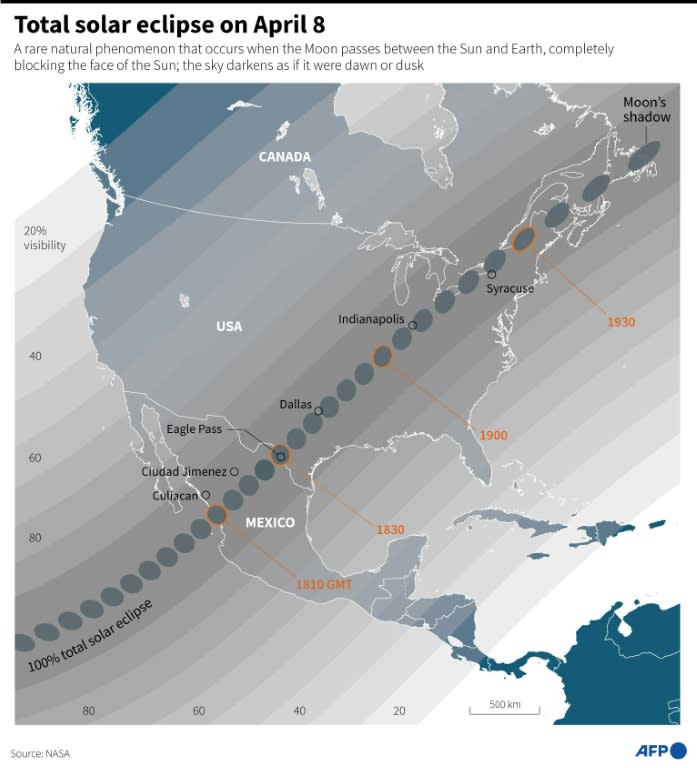Totality insanity: Eclipse mania grips North America

- Oops!Something went wrong.Please try again later.
- Oops!Something went wrong.Please try again later.
Eclipse mania gripped North America on Monday as a breathtaking celestial spectacle observed by tens of millions of people offered a rare convergence of commercial and scientific opportunities -- and an excuse to party.
The Moon's shadow plunged the Pacific coast of Mexico into total darkness at 11:07 am local time (1807 GMT) and swept across the United States at supersonic speed, before it returns to the ocean over Canada's Atlantic coast just under an hour-and-a-half after landfall.
Festivals, viewing parties, and even mass weddings were planned along the eclipse's "path of totality," where the Moon could be seen completely obscuring the Sun for up to a few minutes -- weather permitting. Cloud cover played spoilsport over parts of Texas.
Mexican President Andres Manuel Lopez Obrador visited Sinaloa to witness firsthand the eclipse from the resort of Mazatlan, describing the event as a "very beautiful, unforgettable day."
Thousands gathered in Mexico City, just outside the path of totality. "These are opportunities given by Earth and nature that we must seize," 29-year-old artist Mariana Juarez told AFP.
This year's path of totality is 115 miles (185 kilometers) wide and home to nearly 32 million Americans, with an additional 150 million living less than 200 miles from the strip.
The next total solar eclipse that can be seen from a large part of North America won't come around until 2044.
- 'Freaking nuts' -
Businesses capitalized on the excitement with special events, while hotels and short-term rentals in prime viewing locations were booked solid for months in advance.
At the Stonehenge II park in Ingram, Texas -- a replica of the prehistoric arrangement of stones in England -- eclipse watchers gathered from across the world, screaming and cheering at the moment of totality.
Jeni Lyn Hunter, 57, and her husband Charles Guillory, 60, had traveled from Floresville, Texas. The couple identified as "pagans" and wore Merlin hats.
"It means a lot to me because I have stage four cancer but I'm not giving up, this is a rebirth of the Sun of life," Hunter told AFP.
And in Russellville, Arkansas, more than 300 couples were reportedly set to exchange vows at "A Total Eclipse of the Heart" mass wedding ceremony.
Delta airlines has planned two special flights along the path, while many schools in the zone shut for the day.
- Scientific windfall -
Then there's the science. NASA planned to launch a trio of sounding rockets before, during and just after the eclipse to measure changes caused by the sudden darkness to the ionosphere, an upper layer of the atmosphere important for long-distance radio communication.
The eclipse also offered a golden opportunity to study the Sun's corona, the outer layer of its atmosphere which is normally hidden by the blinding light of the surface, but has an outsized impact on everything from satellites to power grids.
"There's a few high clouds but the beauty of the corona is clearly visible," said NASA heliophysicist Michael Kirk as the eclipse passed through Dallas. "You can see that spiky structure just poking out -- It is heart-stopping beautiful."
He was thrilled that the Sun was near the peak of its 11-year cycle, resulting in an asymmetrical corona. As the eclipse unfolded, the rugged lunar topography revealed itself in a stunning 'diamond ring' effect, while planets like Venus and Jupiter briefly appeared in the sky.
Startling animal behavior has been noted during past eclipses -- roosters can crow as the darkness ends believing it is dawn.
In humans, eclipses trigger feelings of awe as we confront our place within the vast cosmic order. Individuals exhibit more "prosocial" feelings towards each other in the aftermath of the shared experience.
- Safety first -
Former president Donald Trump, who notoriously gazed directly at the Sun during the 2017 eclipse, attempted to capitalize on the phenomenon by releasing a new campaign ad featuring his larger-than-life head blocking out our star.
Health professionals have stressed not to follow his example, urging people to use certified eclipse glasses to prevent permanent retinal injury. President Joe Biden made fun of Trump with a social media post saying "Don't be silly, folks."
Only those within the path of totality can safely remove eye protection and admire the corona peeking out from behind the silhouette of the Moon for a few precious moments.
ia/bgs

